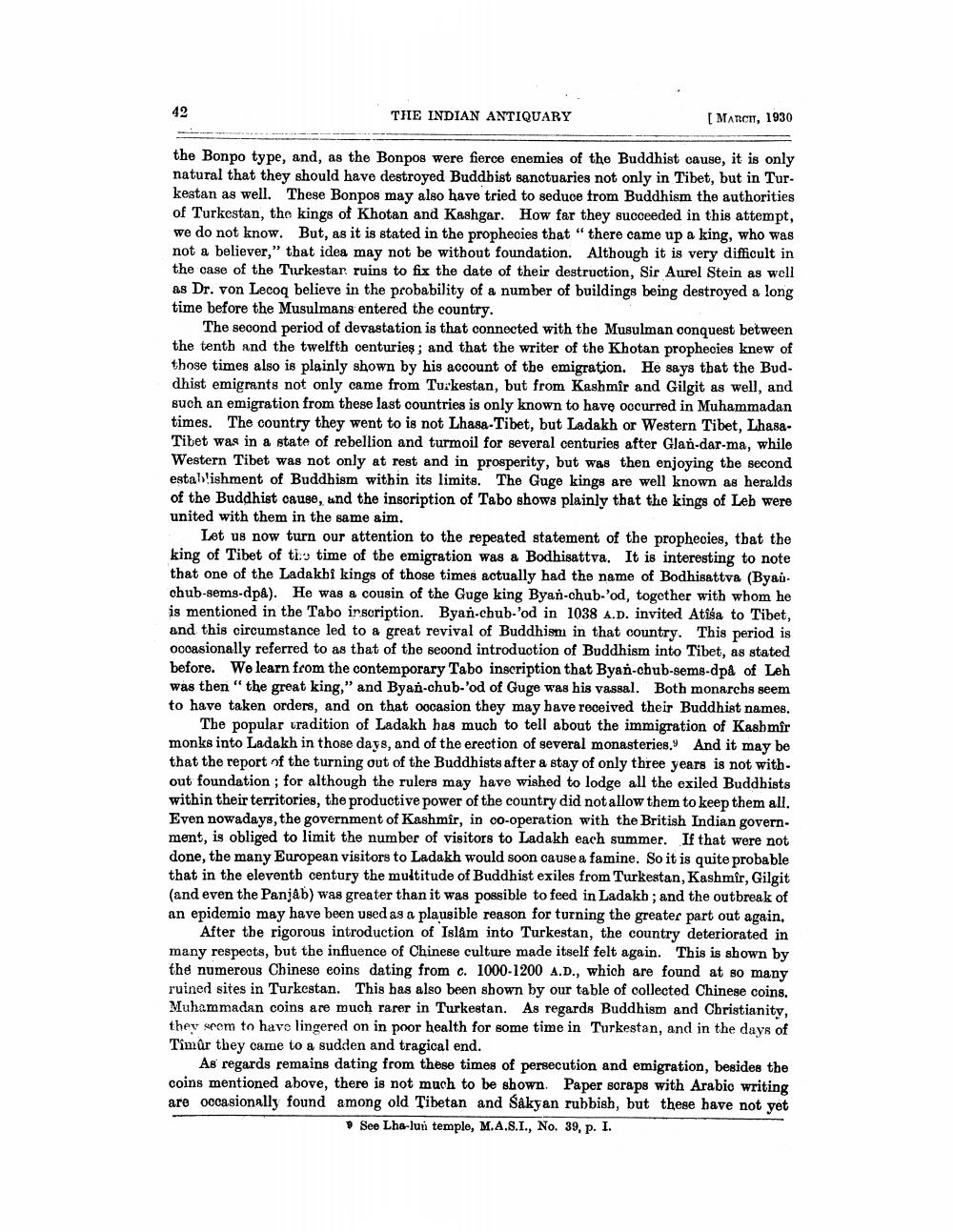________________
THE INDIAN ANTIQUARY
[MARCT, 1930
the Bonpo type, and, as the Bonpos were fierce enemies of the Buddhist cause, it is only natural that they should have destroyed Buddhist sanctuaries not only in Tibet, but in Turkestan as well. These Bonpos may also have tried to seduce from Buddhism the authorities of Turkestan, the kings of Khotan and Kashgar. How far they succeeded in this attempt, we do not know. But, as it is stated in the prophecies that "there came up a king, who was not a believer," that idea may not be without foundation. Although it is very difficult in the case of the Turkestar ruins to fix the date of their destruction, Sir Aurel Stein as well as Dr. von Lecoq believe in the probability of a number of buildings being destroyed a long time before the Musulmans entered the country.
The second period of devastation is that connected with the Musulman conquest between the tenth and the twelfth centuries, and that the writer of the Khotan prophecies knew of those times also is plainly shown by his account of the emigration. He says that the Bud. dhist emigrants not only came from Turkestan, but from Kashmir and Gilgit as well, and such an emigration from these last countries is only known to have occurred in Muhammadan times. The country they went to is not Lhasa-Tibet, but Ladakh or Western Tibet, LhasaTibet was in a state of rebellion and turmoil for several centuries after Glan-dar-ma, while Western Tibet was not only at rest and in prosperity, but was then enjoying the second establishment of Buddhism within its limits. The Guge kings are well known as heralds of the Buddhist cause, and the inscription of Tabo shows plainly that the kings of Leb were united with them in the same aim.
Let us now turn our attention to the repeated statement of the prophecies, that the king of Tibet of ti9 time of the emigration was a Bodhisattva. It is interesting to note that one of the Ladakhi kings of those times actually had the name of Bodhisattva (Byao. chub-sem-dpa). He was a cousin of the Guge king Byan-chub-'od, together with whom he is mentioned in the Tabo inscription. Byan.chub-'od in 1038 A.D. invited Atisa to Tibet, and this circumstance led to a great revival of Buddhism in that country. This period is occasionally referred to as that of the second introduction of Buddhism into Tibet, as stated before. We learn from the contemporary Tabo inscription that Byan-chub-sems-dpå of Leh was then "the great king," and Byan-chub-'od of Guge was his vassal. Both monarchs seem to have taken orders, and on that occasion they may bave received their Buddhist names.
The popular tradition of Ladakh has much to tell about the immigration of Kashmir monks into Ladakh in those days, and of the erection of several monasteries. And it may be that the report of the turning out of the Buddhists after a stay of only three years is not with. out foundation ; for although the rulers may have wished to lodge all the exiled Buddhists within their territories, the productive power of the country did not allow them to keep them all. Even nowadays, the government of Kashmir, in co-operation with the British Indian govern. ment, is obliged to limit the number of visitors to Ladakh each summer. If that were not done, the many European visitors to Ladakh would soon cause a famine. So it is quite probable that in the eleventh century the multitude of Buddhist exiles from Turkestan, Kashmir, Gilgit (and even the Panjab) was greater than it was possible to feed in Ladakh ; and the outbreak of an epidemio may have been used as a plausible reason for turning the greater part out again,
After the rigorous introduction of Islåm into Turkestan, the country deteriorated in many respects, but the influence of Chinese culture made itself felt again. This is shown by the numerous Chinese eoins dating from c. 1000-1200 A.D., which are found at so many ruined sites in Turkestan. This has also been shown by our table of collected Chinese coins. Muhammadan coins are much rarer in Turkestan. As regards Buddhism and Christianity, ther seem to have lingered on in poor health for some time in Turkestan, and in the days of Timur they came to a sudden and tragical end.
As regards remains dating from these times of persecution and emigration, besides the coins mentioned above, there is not much to be shown. Paper scraps with Arabic writing are occasionally found among old Tibetan and Sakyan rubbish, but these have not yet
See Lha-lun temple, M.A.S.I., No. 39, p. I.




